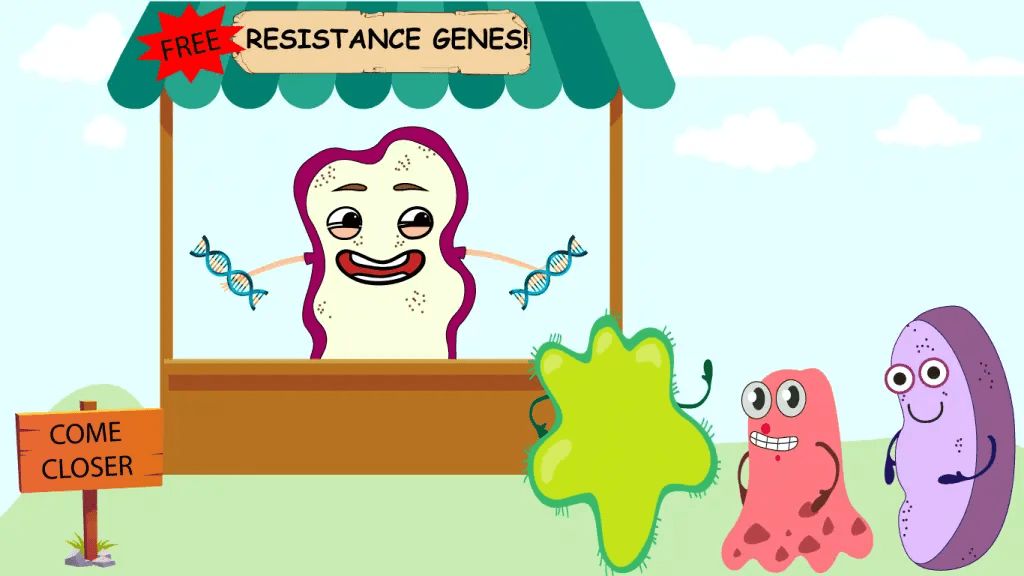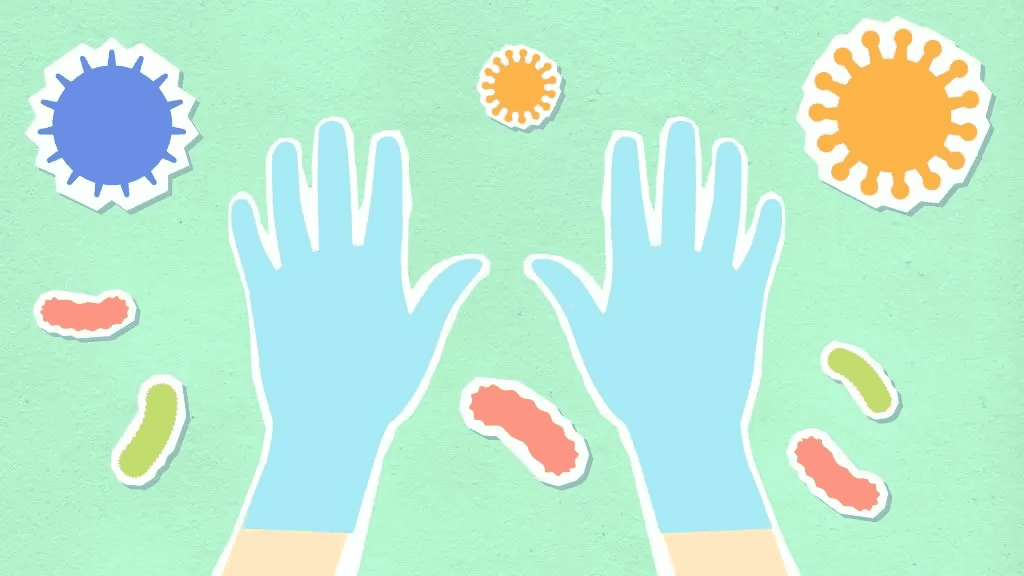
Namrata Pandit
&

Pornima Rajkarne
Which dawned before— The antibiotic or the resistance? Find hints in this piece. In the previous article in this series – The Perils of Antibiotic Resistance, we introduced you to antibiotic resistance. Here, we look at the science at work in antibiotic resistance. We learn about the evolutionary race between antibiotics and bacteria to fight each other and how that impacts health and medicine.
When antibiotic-resistant genes are acquired by bacteria, they go unaffected upon treatment with an antibiotic.
Illustration by Namrata Pandit, developed for SciRio by Leeba Ann Chacko
The golden age of antibiotic discovery and development was from 1950 to 1960, when most of the current antibiotics were discovered. Antibiotics act by interfering with key biological processes of the bacterial cell by binding or blocking particular sites within a cell. After this phase of intensive development, there was a surge of rapidly evolving resistance to antibiotics due to their overuse or misuse. This led to a major dip in the availability of antibiotics that would work. The rate of resistance from bacteria surpassed the rate of development of new antibiotics. But how did the bacteria become so resistant to antibiotics?
Antibiotic resistance is conferred to bacteria due to various mechanisms. The genes present in bacteria are responsible for the development of such mechanisms. These antibiotic-resistant genes may be a result of genetic mutations i.e., changes in the sequence of DNA that get inherited. Another method is by the physical transfer or passing of these genes from one bacteria to another through a process called Horizontal Gene Transfer (HGT). The latter may occur in the same species and sometimes across species.
Creative representation of Horizontal Gene Transfer (HGT)
Illustration by Namrata Pandit, developed for SciRio by Leeba Ann Chacko

On acquiring resistance, bacteria display many self-defence mechanisms. In antibiotic-resistant bacteria, these binding sites may be modified such that the antibiotic cannot bind to them. There are other common self-defence mechanisms employed too: Preventing the entry of the antibiotic molecules; expelling the antibiotic molecules out of the cell; modify the antibiotic in such a way that it no longer harms the cell or destroying the antibiotic molecule altogether using enzymes.
Studying such mechanisms used by bacteria for antibiotic resistance gives us an insight into what causes their evolution — both, the hostile environment that drives it, and the adaptations that are selected for, in the course of evolution.
Which came before – the antibiotic or the resistance?
Initially, researchers only noticed antibiotic resistance in patients who were treated with antibiotics. But, on the other hand, the presence of horizontal gene transfer told a different story – antibiotic-resistant genes may have existed even before the discovery and widespread use of specific antibiotics. For example, in 1940, Abraham and Chain discovered penicillinase, an enzyme produced by bacteria that can destroy penicillin. Penicillin is an antibiotic whose large-scale production for commercial use started after 1943, during the second world war. The existence of penicillinase in the environment before the widespread use of antibiotic penicillin sheds light on the possibility of naturally occurring resistance genes without the use of antibiotics in the first place.
It is believed that antibiotic resistance in bacteria evolved as a defensive mechanism to protect themselves from toxins produced from other microbes. If microbes produce antibiotics, other microbes must have defence mechanisms in place to guard themselves. The ability to defend would then be stored as genetic information, integrated into the species and subspecies that survive.
How do humans influence antibiotic resistance?

Our role in Antibiotic Resistance continues to evolve.
Image credit: Pexels
Human activity has led to a significant increase in pressure on bacterial populations to evolve into more efficient forms. Humans use biocides (chemicals that kill living organisms especially microbes) in their daily life ranging from handwash, cosmetic products, detergents and extended use in agriculture and poultry farming. Exposure to antibiotics and biocides kill non-resistant bacteria without affecting resistant bacteria. Thus, the resistant bacteria increase in number and continue to infect humans and other living beings. The current surge in biocides usage can fasten the process of antimicrobial resistance. In light of the ongoing pandemic, an undeniable rise in the use of biocides can be a major driving force in antimicrobial resistance. While sanitisers and disinfectants are unavoidable, there are certain products that are commercially sold on a large scale preying on the present need to be extra safe.
For instance, vegetables and fruits need not be washed with soap water or any other biocides. Yet a number of biocide-containing products are marketed for the use of washing vegetables and fruits.
Being wary of using only what is ‘needed’ and what is not, in the usage of biocides can go a long way to prevent fuelling AMR further.
Our role in antibiotic resistance continues to evolve
Antibiotics are not mere commodities in medicine. Without them, the quality of current healthcare would likely relapse into the pre-antibiotic era. The financial and clinical burden of antibiotic resistance is heavy on public health and welfare. We are in the midst of constant war. Combating AMR by doing our part – as the public, the healthcare system, the policymakers, and the scientists – is key.
In a country like India, antibiotics are accessible to the general public, often in an unregulated manner, which increases the risk of a surge in antibiotic resistance. Can the doctors, pharmacists, or any registered medical practitioners in India contribute to saving us from the crisis of antibiotic resistance? What is the responsibility of the public to prevent this? To know more, read the next article of the series where we will look at ways to prevent and control antibiotic resistance.
Edited by: Hansika Chhabra and Pornima Rajkarne
References:
Peterson, E., & Kaur, P. (2018). Antibiotic Resistance Mechanisms in Bacteria: Relationships Between Resistance Determinants of Antibiotic Producers, Environmental Bacteria, and Clinical Pathogens. Frontiers in Microbiology, 9, 1. https://doi.org/10.3389/fmicb.2018.02928
Davies, J., & Davies, D. (2010). Origins and Evolution of Antibiotic Resistance. Microbiology and Molecular Biology Reviews, 74(3), 417–433. https://doi.org/10.1128/mmbr.00016-10
Sinha, R. (2020, July 3). COVID-19: Why biocide overuse needs to be addressed to tackle AMR. Down to Earth. https://www.downtoearth.org.in/blog/health/covid-19-why-biocide-overuse-needs-to-be-addressed-to-tackle-amr-72110
Davies J. (2006). Where have All the Antibiotics Gone?. The Canadian journal of infectious diseases & medical microbiology = Journal canadien des maladies infectieuses et de la microbiologie medicale, 17(5), 287–290. https://doi.org/10.1155/2006/707296
Munita, J. M., & Arias, C. A. (n.d.). Mechanisms of Antibiotic Resistance. Virulence Mechanisms of Bacterial Pathogens, Fifth Edition, 481–511. doi:10.1128/microbiolspec.vmbf-0016-2015
Harbottle, H., Thakur, S., Zhao, S., & White, D. G. (2006). Genetics of Antimicrobial Resistance. Animal Biotechnology, 17(2), 111–124. doi:10.1080/10495390600957092
Read, A. F., & Woods, R. J. (2014). Antibiotic resistance management. Evolution, Medicine, and Public Health, 2014(1), 147–147. doi:10.1093/emph/eou024
Zaman, S. B., Hussain, M. A., Nye, R., Mehta, V., Mamun, K. T., & Hossain, N. (2017). A Review on Antibiotic Resistance: Alarm Bells are Ringing. Cureus. doi:10.7759/cureus.1403
C. Lee Ventola, MS, The Antibiotic Resistance Crisis, Part 1: Causes and Treats
Pollock, M. (1971). The Function and Evolution of Penicillinase. Proceedings of the Royal Society of London. Series B, Biological Sciences, 179(1057), 385-401. Retrieved February 21, 2021, from http://www.jstor.org/stable/75979
Alexander Fleming Discovery and Development of Penicillin – Landmark. (n.d.). American Chemical Society. https://www.acs.org/content/acs/en/education/whatischemistry/landmarks/flemingpenicillin.html#wwii-penicillin-commercial-production





